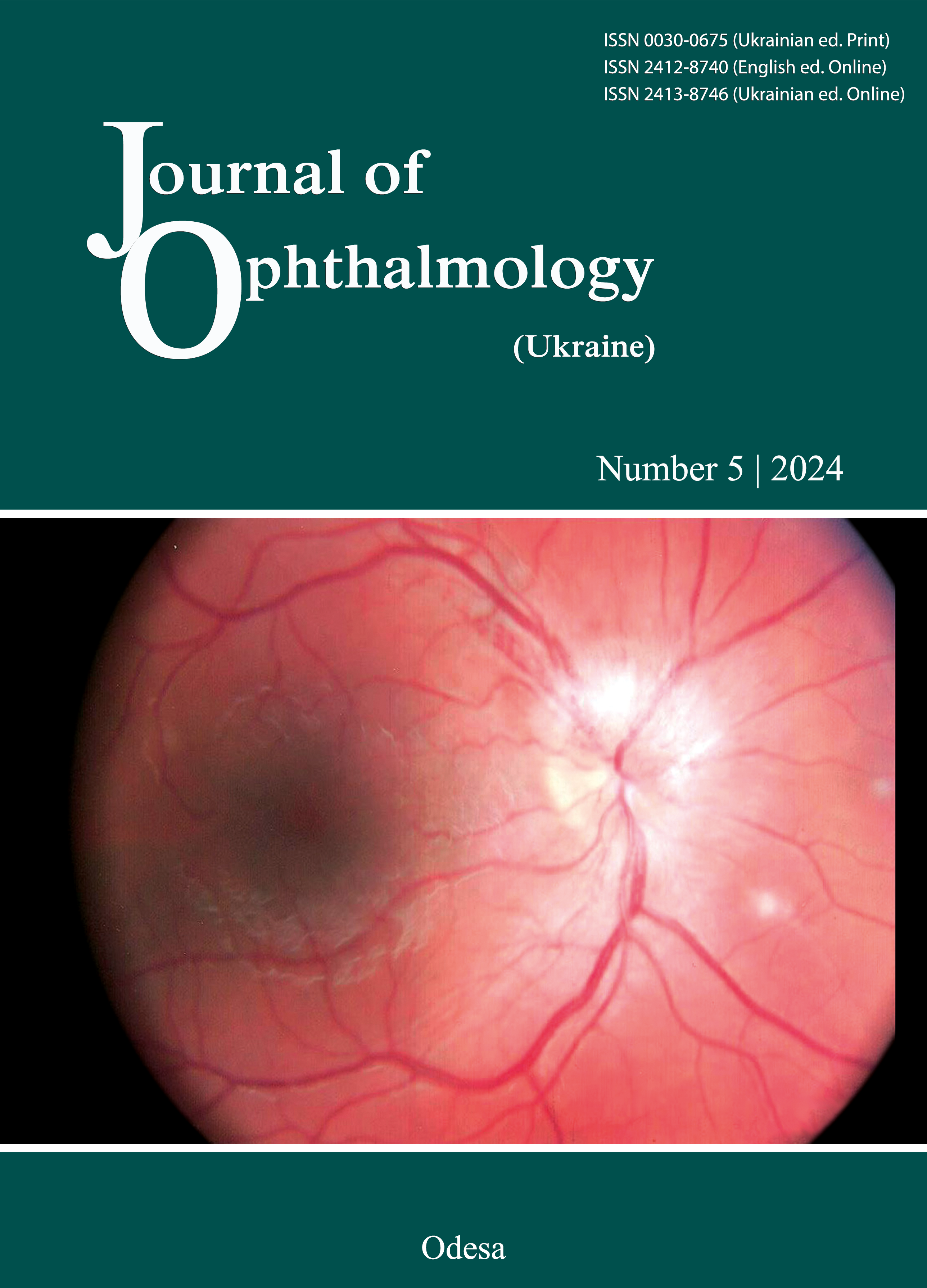Characteristics of redox processes, thiol system and mucin in the tear fluid in type 2 diabetics
DOI:
https://doi.org/10.31288/oftalmolzh2024539Keywords:
type 2 diabetes mellitus, redox processes, ocular surface, thiol status, mucin, tear, conjunctival impression cytology, Nelson grades, squamous metaplasiaAbstract
Purpose: To assess the characteristics of redox processes, thiol system and mucin in the tear fluid in patients with T2DM.
Material and Methods: Thirty type 2 diabetics (60 eyes) with ocular surface changes were included in the study. Patient eyes were divided into groups based on the bulbar conjunctival changes corresponding to the Nelson grade: group 1 (33 eyes with Nelson grade 2 to 3 changes in the bulbar conjunctiva) and group 2 (27 eyes with Nelson grade 0 to 1 changes in the bulbar conjunctiva). Tear lactate dehydrogenase (LDH), glucose-6-phosphate dehydrogenase (G6PDH), malate dehydrogenase (MDH), and glutathione peroxidase (GPX) activities and tear mucin, reduced glutathione (GSH) and oxidized glutathione (GSSG) levels were determined by routine techniques.
Results: We found alterations in tear redox reactions (LDH, G6PDH and MDH activities), GPX activity and thiol status (GSH and GSSG levels) in the setting of cytological conjunctival changes (i.e., different Nelson grades of squamous metaplasia) in type 2 diabetics. In addition, we found decreased tear mucin levels, which could be associated with alterations in the above biochemical processes and/or cytological conjunctival changes in patients of these groups.
Conclusion: Determining characteristics of tear redox reactions, glutathione system and mucin level can be considered as a method for monitoring the course of ocular surface disease based on the grade of squamous metaplasia of the bulbar conjunctiva in type 2 diabetics.
References
Umapathy A, Donaldson P, Lim J. Antioxidant Delivery Pathways in the Anterior Eye. BioMed Res Int. 2013;2013:207250. https://doi.org/10.1155/2013/207250
Schillern EEM, Pasch A, Feelisch M, Waanders F, Hendriks SH, Mencke R, et al. Serum free thiols in type 2 diabetes mellitus: A prospective study. J Clin Transl Endocrinol. 2019 Jun;16:100182. https://doi.org/10.1016/j.jcte.2019.100182
Lu SC. Regulation of glutathione synthesis. Mol Aspects Med. 2009;30(1-2):42-59. https://doi.org/10.1016/j.mam.2008.05.005
Dogru M, Kojima T, Simsek C, Tsubota K. Potential Role of Oxidative Stress in Ocular Surface Inflammation and Dry Eye Disease. Invest Ophthalmol Vis Sci. 2018;59(14) https://doi.org/10.1167/iovs.17-23402
Jin K, Ge Y, Ye Z, et al. Anti-oxidative and mucin-compensating dual-functional nano eye drops for synergistic treatment of dry eye disease. Appl Mater Today. 2022;27:101411. https://doi.org/10.1016/j.apmt.2022.101411
Lutchmansingh FK, Hsu JW, Bennett FI, et al. Glutathione metabolism in type 2 diabetes and its relationship with microvascular complications and glycemia. PLoS One. 2018;13(6). https://doi.org/10.1371/journal.pone.0198626
Koval TV, Nazarova OO, Matyshevska OP. [Changes in glutathione levels in rat thymocytes exposed to H2O2 or radiation-induced apoptosis]. Ukrainian Biochemical Journal. 2008;80(2):114-9. Ukrainian.
van Dijk PR, Pasch A, van Ockenburg-Brunet SL, et al. Thiols as markers of redox status in type 1 diabetes mellitus. Ther Adv Endocrinol Metab. 2020;11:2042018820903641. https://doi.org/10.1177/2042018820903641
Alves Mde C, Carvalheira JB, Modulo CM, Rocha EM. Tear film and ocular surface changes in diabetes mellitus. Arq Bras Oftalmol. 2008;71(6 suppl):96-103. https://doi.org/10.1590/S0004-27492008000700018
Aoyama K, Nakaki T. Impaired glutathione synthesis in neurodegeneration. Int J Mol Sci. 2013;14(10):21021-44. https://doi.org/10.3390/ijms141021021
Pavlovschi E, et al. Glutathione-related antioxidant defense system in patients with hypertensive retinopathy. Rom J Ophthalmol. 2021;65(1):46-53. https://doi.org/10.22336/rjo.2021.9
Zhmud TM, Drozhzhyna GI, Demchuk AV. Cytological features of the bulbar conjunctiva in patients with type 2 diabetes mellitus. J Ophthalmol (Ukraine). 2021;1:24-31. https://doi.org/10.31288/oftalmolzh202112431
Craig JP, et al. TFOS DEWS II Definition and Classification Report. Ocul Surf. 2017;15(3):276-283. https://doi.org/10.1016/j.jtos.2017.05.008
Bron AJ, Evans VE, Smith JA. Grading of corneal and conjunctival staining in the context of other dry eye tests. Cornea. 2003;22(7):640-50. https://doi.org/10.1097/00003226-200310000-00008
Bergmeyer HU. Methoden der Enzymatischen Analyse. Berlin:Akademie Verlag. 1970;441-442. https://doi.org/10.1515/9783112719299
Bergmeyer HU. Methoden der Enzymatischen Analyse. Berlin:Akademie Verlag.1970;417-418. https://doi.org/10.1515/9783112719299
Bergmeyer HU. Methoden der Enzymatischen Analyse. Berlin:Akademie Verlag.1970; 446-447. https://doi.org/10.1515/9783112719299
Baumber J, Ball BA. Determination of glutathione peroxidase and superoxide dismutase-like activities in equine spermatozoa, seminal plasma, and reproductive tissues. Am J Vet Res. 2005 Aug;66(8):1415-1419. https://doi.org/10.2460/ajvr.2005.66.1415
Romanenko EG, Klenina IA. [Method for determining total saliva proteins]. Svit biologii ta medytsyny. 2012;4:91-93. Russian.
Bergmeyer HU. Methoden der Enzymatischen Analyse. Berlin:Akademie Verlag.1970; 1605-1609. https://doi.org/10.1515/9783112719299
Oguntibeju OO. Type 2 diabetes mellitus, oxidative stress and inflammation: examining the links. Int J Physiol Pathophysiol Pharmacol. 2019;11(3):45-63. PMID:31333808; PMCID
Rehman K, Akash MSH. Mechanism of generation of oxidative stress and pathophysiology of type 2 diabetes mellitus: how are they interlinked? J Cell Biochem. 2017;118:3577-3585. https://doi.org/10.1002/jcb.26097
Navarro JF, Mora C. Role of inflammation in diabetic complications. Nephrol Dial Transplant. 2005;20:2601-4. PMID:16199463
https://doi.org/10.1093/ndt/gfi155
Giacco F, Brownlee M. Oxidative stress and diabetic complications. Circ Res. 2010;107:1058-70.
https://doi.org/10.1161/CIRCRESAHA.110.223545
Wellen KE, Hotamisligil GS. Inflammation, stress, and diabetes. J Clin Invest. 2005;115:1111-9. https://doi.org/10.1172/JCI25102
Zhang P, et al. Global healthcare expenditure on diabetes for 2010 and 2030. Diabetes Res Clin Pract. 2010;87:293-301. PMID:20206466. https://doi.org/10.1016/j.diabres.2010.01.026
Petrunia AM, Kutaini MA. [Studies on thiol metabolism and redox processes in the cornea in the setting of experimental conjunctivitis]. Problemy ekologichnoi ta medychnoi generyky s klinichnoi imunologii. 2012;(109):259-72. Ukrainian.
Selivanova OV. [Clinical and experimental rationale for correcting thiol concentration in the conjunctiva and tears in the medical treatment for conjunctivitis]. [Abstract of a thesis for a degree of Cand Sc (Med)]. Kyiv; 2011. Ukrainian.
Semes'ko SG. [The clinical significance of a study on the antioxidant status in ophthalmology]. Vestn Oftalmol. 2005 May-Jun;121(3):44-7. Russian.
Zhmud TM. [Study of the thiol system redox potentials in the cornea in experimental keratitis on the background of diabetes progression]. Oftalmol Zh. 2015;(6):46-9. Ukrainian.
Zhmud TM. [Intensity of redox processes in the cornea in experimental keratitis in the presence of diabetes]. Oftalmologiia. 2015;2(2):202-10. Ukrainian.
Downloads
Published
How to Cite
Issue
Section
License
Copyright (c) 2024 Zhmud T. M., Drozhzhyna G. I.

This work is licensed under a Creative Commons Attribution 4.0 International License.
This work is licensed under a Creative Commons Attribution 4.0 International (CC BY 4.0) that allows users to read, download, copy, distribute, print, search, or link to the full texts of the articles, or use them for any other lawful purpose, without asking prior permission from the publisher or the author as long as they cite the source.
COPYRIGHT NOTICE
Authors who publish in this journal agree to the following terms:
- Authors hold copyright immediately after publication of their works and retain publishing rights without any restrictions.
- The copyright commencement date complies the publication date of the issue, where the article is included in.
DEPOSIT POLICY
- Authors are permitted and encouraged to post their work online (e.g., in institutional repositories or on their website) during the editorial process, as it can lead to productive exchanges, as well as earlier and greater citation of published work.
- Authors are able to enter into separate, additional contractual arrangements for the non-exclusive distribution of the journal's published version of the work with an acknowledgement of its initial publication in this journal.
- Post-print (post-refereeing manuscript version) and publisher's PDF-version self-archiving is allowed.
- Archiving the pre-print (pre-refereeing manuscript version) not allowed.












